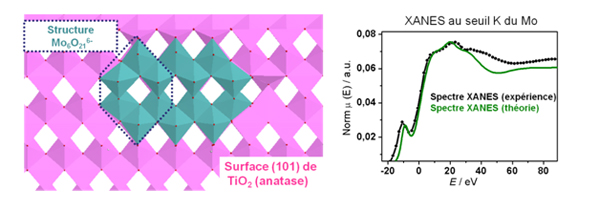Supported molybdenum catalysts are widely used in their sulfide state in the treatment petroleum fractions, which are important economic and environmental issues. In their oxide states they can be used in the partial oxidation of ethanol and methanol.
Groups in Lille and Grenoble have used X-ray absorption spectroscopy on the SAMBA beamline to better understand, on a molecular level, the structure of the active phase of these catalysts (Mo) and how it interacts with the support. The long-term aim is to improve the catalytic performance of this type of material.
While improvements in the performance of molybdenum-based catalysts requires an understanding, at the molecular level, of the structure of their active phase (Mo) and their mode of interaction with the support (usually an oxide of high specific surface, in this case TiO2 (anatase)), the non-crystalline nature of these materials often makes standard structural characterization techniques such as X-ray diffraction inadequate. This is why groups at UCCS and the Neel Institute chose X-ray absorption spectroscopy (XAS) on the SAMBA beamline as the main characterization technique.
XANES probes the electronic structure around Mo
The researchers focused on the XANES part of the XAS spectrum, which is defined as the region centered about the E0 energy absorption edge within the interval [E0 - 20 eV; E0 + 100eV]. Although EXAFS is often used to characterize catalysts in heterogeneous catalysis, XANES is also known to be very sensitive to the stereochemical environment around the absorber atom. In addition, as the amplitude of XANES spectra is proportional to the density of unoccupied states, this technique can be regarded as a true probe of the electronic structure around the absorber atom. Detailed analysis of the XANES signal was possible thanks to the prior modeling of experimental spectra of components of known structures in the context of the multiple scattering theory. Simulating the theoretical spectra of these known allowed the correlation of each spectroscopic fingerprint with structural information.
Six MoO6 octahedra interacting with TiO2
Based on these findings and the characteristics of the catalyst’s experimental spectrum, the scientists generated theoretical models of probable structures of the active species on the TiO2 surface, the geometry of which were validated using density functional theory (DFT) calculations. The best experiment/theory agreement was obtained for a structure of supported oxomolybdates consisting of units of six molybdenum octahedra in "epitaxial" interaction with the support surface (here TiO2, see Figure). This result thus showed the important role played by the oxide support in the genesis of the oxomolybdate phase, where the speciation of molybdenum depends strongly on the structure of the oxide surface, which directly controls the way the MoO6 octahedra are arranged.

